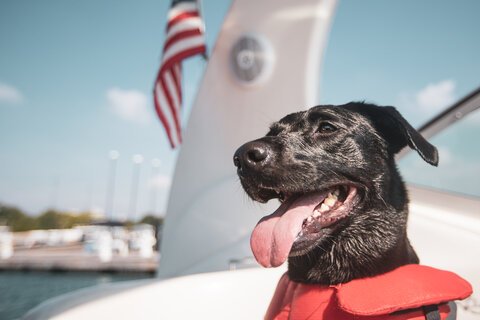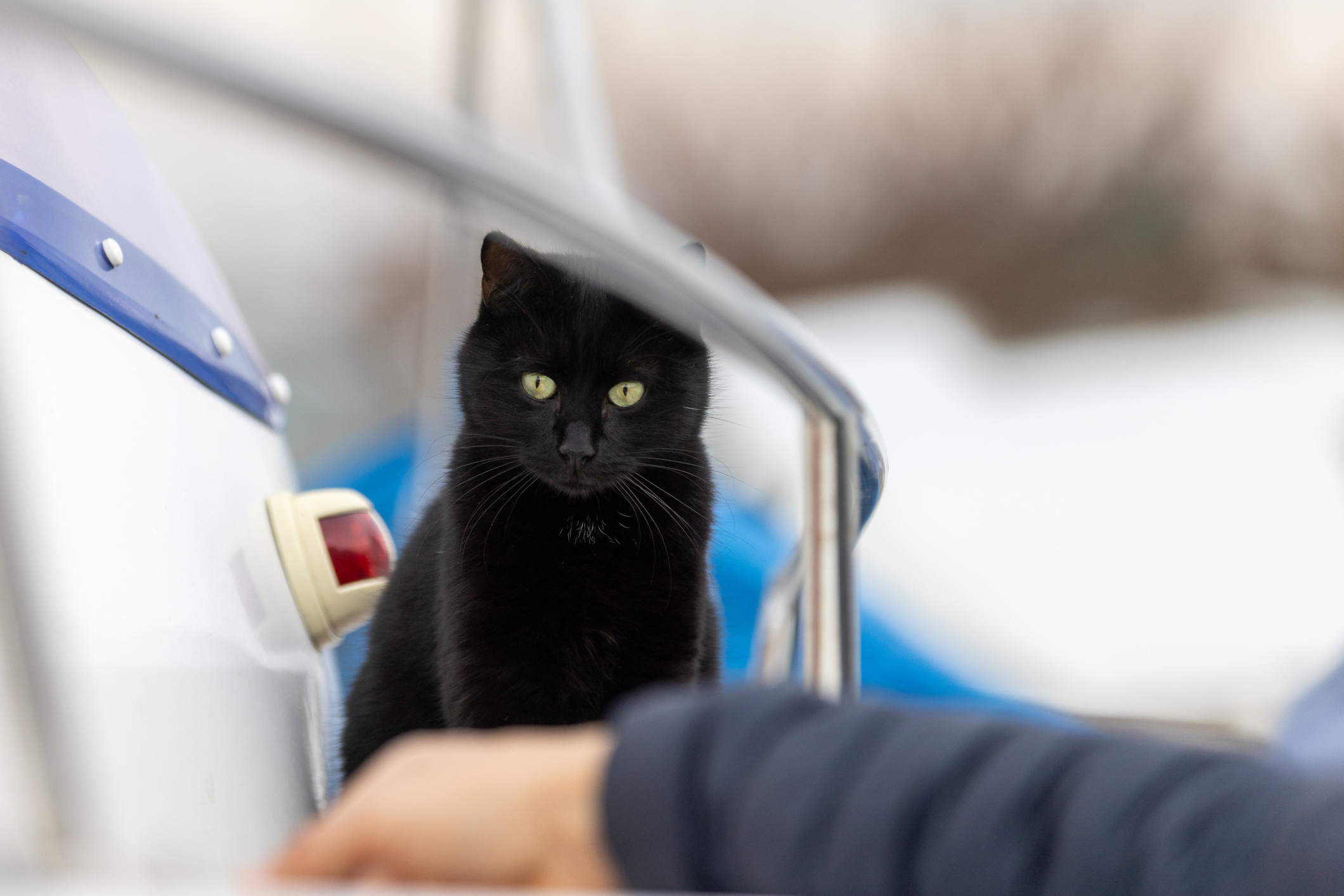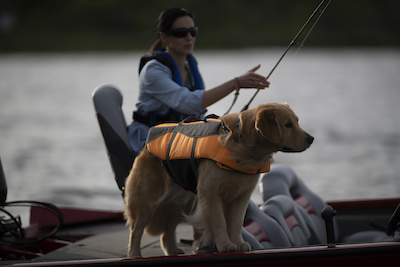Nothing beats reeling in a big one. Unless, of course, you're doing it with a furry friend by your side. Bringing your four-legged fishing buddy along for the ride will transform any solo outing into the perfect fishing adventure. But it probably won't happen overnight.
Both an elaborate vessel and a compact fishing kayak with a dog in tow can present potential hazards. And trust us – jumping in the water after your furry friend is a surefire way to ruin your day.
That's why we wrote this comprehensive fishing guide for dog owners. We're delving beyond basic safety precautions to detail the specific training, gear, and prep needed to make fishing with your dog an enjoyable, stress-free experience.
Tip #1: Safety Always Comes First
Now, before even loading that tackle box, you have to make sure your pup is ready for the occasion. Safety equipment is non-negotiable when fishing with dogs – especially when you're far from shore.
Read Next: Must-Have Accessories for Your Boat Dog
Get a Dog-Friendly Life Jacket
Even if your dog is a strong swimmer, a dog-friendly life jacket is the most critical piece of gear. Current and exhaustion can panic any pet if they fall out of your kayak or boat.
Here's a quick overview of what to look for:
- Handle Power: Ensure the jacket features a robust rescue handle firmly attached to the back. It'll allow you to easily hoist your dog out of the water and back onto the boat in the unfortunate event that they end up overboard.
- Secure Fit: Make sure the jacket fits snugly around their chest and belly (just like it should on a human). We always recommend testing it in shallow water beforehand. Remember, the jacket shouldn't ride up or choke them when you lift it by the handle.
- Visibility: Go for bright, high-visibility colors (like neon orange). If your fishing buddy does go overboard, you need to spot them instantly against the water's glare.
Then, You'll Need a Leash
When you bring your dog along for the ride, you need constant control. In other words, you need to keep them from snagging your line, chasing birds, or startling the fish.
- Keep Them on a Short Leash (Literally): A short, fixed leash (four to six feet) will help you maintain control of your pup while they're on board. This might go without saying, but ensure you always have immediate access to it. A leash is useless if you can't easily grab it.
- Use Tethers to Establish a Radius: On a stationary boat or fishing kayak with a dog, use a short tether to establish a radius where your dog can move freely about the cabin. That way, they won't be able to mess with your lines, scarf your bait, or accidentally go for a swim.
Hydration and Paw Protection
Fishing trips mean long hours under the sun. So, don't forget to pack a dog bowl, snacks, and plenty of fresh water.
- Sun and Heat: Dogs absorb heat easily (especially if they have darker coloring), so consider a cooling vest or mat. Also, note that boat surfaces can get dangerously hot, so be mindful of their paws.
- Paw Protection: When fishing in rugged areas with river crossings or rocky shorelines, dog boots are a great idea. At a minimum, make sure you're checking their paws regularly for cuts.
Tip #2: Master Dockside Manners
The key to a relaxing day fishing with your dog lies in preemptive training. Long story short, you must train your dog for stability and self-control.
Why Time Training Pays Off
Spending dedicated time training takes your dog from a distraction into a calm, quiet fishing buddy. Know this isn't about teaching silly tricks – it's about building bulletproof reliability in high-distraction environments. You'll want to start training well before you ever step near the water.
The Core Commands: Sit, Stay, and Stability
Your basic living room commands aren't enough on a rocking boat. You need to practice duration and stability.
- Sit/Stay: Your dog needs to be able to sit — and stay — for 15-20 minutes, even with lots of distractions. We recommend practicing the "sit, stay" command on unstable surfaces (think: a wobbly chair, a cushion, or a paddleboard on the grass). Your dog needs to understand that "stay" means maintaining its position, regardless of the boat's movement.
- Down: "Down" is a solid command if you're venturing onto a fishing kayak with a dog. As the name suggests, it lowers your dog's center of gravity, which is crucial for stability.
The "Fishing" Commands: Leave It!
"Leave It" is the single most valuable tool for fishing with your dog. Everything in a fishing context is tempting, dangerous, or both.
- Leave It Commands for Gear: Teach your dog that bait, lines, and lures are totally off-limits. Practice with smelly rewards (like fish treats) near your actual fishing gear. Your dog must understand that "leave it" applies to anything that smells like the catch.
- Leave It Commands for the Catch: When you land a fish, your dog's instinct will be to investigate. However, this is uber dangerous thanks to the hooks, slime, scales, and sharp fins. Practice landing a toy or a mock fish on the ground and immediately enforcing "leave it" from a distance. Your priority during the catch should always be your pup's safety.
- Drop It: This command is essential if your dog manages to grab a lure or piece of line. It could save you an emergency vet visit.
No Jumping Allowed
While jumping in the water is fun, it spooks the fish and creates a safety issue.
- Controlled Entry: Teach your dog a specific command (think: "swim") that grants them permission to enter the water. Be diligent about correcting them every time they try to jump otherwise.
- Practice the Perimeter: By keeping the dog contained in a "stay" a few feet from the water's edge, they learn that the perimeter is their boundary.
Tip #3: Prepare Them for the Fishing Platform
A successful trip hinges on preparing your fishing buddy for the environment before the fishing adventure. Don't let the first time they feel a boat rock be your first fishing day.
Acclimation to Boats and Kayaks
Unstable or noisy surfaces cause anxiety, which leads to sudden movements.
- Boat Training: Before embarking on your adventure, let them explore and give them plenty of treats. Practice the "sit," "stay," and "down" commands inside and on top while simulating rocking motions.
- Special Focus for Kayaks: Space is tight on top of a kayak or canoe. Therefore, your dog needs to learn one specific spot and stay there. Since their movements drastically affect stability, practice short, stable sessions on calm water first – focusing on having them lie down to lower their center of gravity.
Shoreline and River Acclimation
A little extra prep is required if your fishing expedition involves hiking, rough terrain, or river crossings.
- Terrain Practice: Train your dog to walk (calmly) beside you on rocky, uneven trails while they're on a leash.
- River Crossings: If you need to cross a river or stream, introduce your dog to this scenario safely. They need to learn to move through the current while staying close. And always keep one hand on the handle of their life jacket when crossing deep or fast water.
Tip #4: How to Maximize Enjoyment
At the end of the day, isn't the goal a relaxing, enjoyable day fishing with your pup?
Know Your Limits and Take Breaks
Don't set out for a twelve-hour excursion on the very first day. Instead, we recommend keeping the first few outings short and sweet.
- Breaks are Essential: Schedule frequent breaks (on dry land) so your dog can stretch and shake off any water.
- Motion Sickness: Watch for signs of motion sickness (drooling, lethargy, panting, etc.). And if your dog gets sick, it's time to head in. You can also consult with your vet about medication beforehand.
Managing the Catch Safely
Let's be honest. Reeling in a big one can get a little out of hand. And with a four-legged friend on board, this is when the threat of injury is highest.
- Immediate Separation: As soon as you feel a fish on the line, enforce the "sit," "stay," or "down" commands and separate your fishing buddy from the action.
- The De-Hooking Zone: Always de-hook the fish far away from your dog. Once it's unhooked, immediately place it in a cooler or live well anywhere that your dog won't be able to access it. Never allow your dog to play with the catch.
The Value of Sharing the Adventure
As you'll quickly find out, fishing with your dog is an incredibly special experience. With dedicated training and preparation, we're confident you'll settle into a routine. Sure, it takes a bit of patience and commitment, but the reward—a calm, controlled fishing buddy by your side—is priceless.


